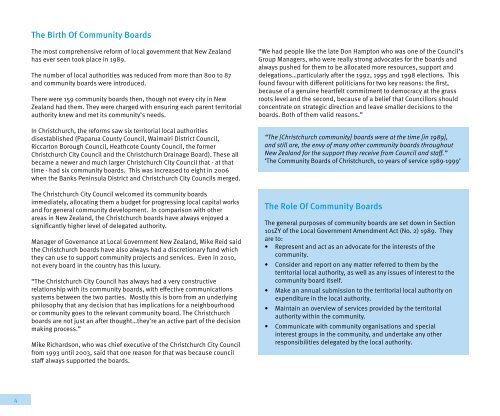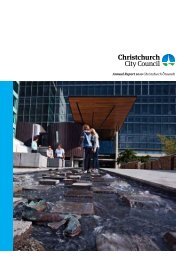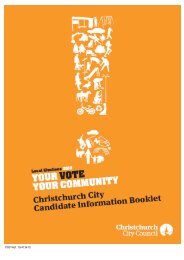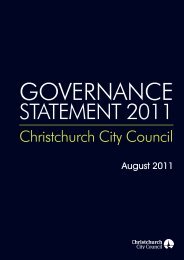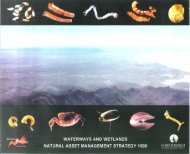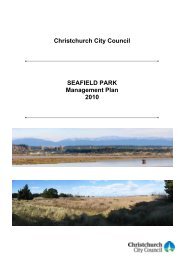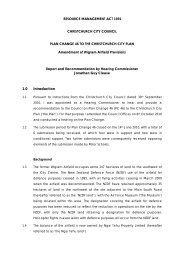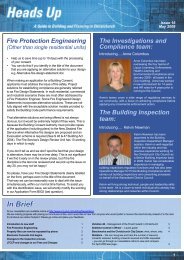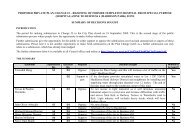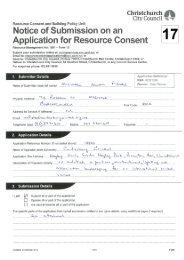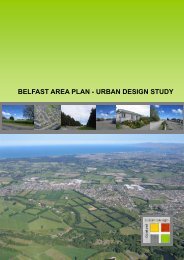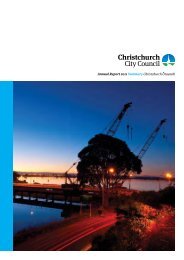Shirley-Papanui Community Board 1989-2010 - Christchurch City ...
Shirley-Papanui Community Board 1989-2010 - Christchurch City ...
Shirley-Papanui Community Board 1989-2010 - Christchurch City ...
You also want an ePaper? Increase the reach of your titles
YUMPU automatically turns print PDFs into web optimized ePapers that Google loves.
HILLS RD<br />
The Birth Of <strong>Community</strong> <strong>Board</strong>s<br />
The <strong>Shirley</strong>-<strong>Papanui</strong> <strong>Community</strong> <strong>Board</strong> – An Overview<br />
The most comprehensive reform of local government that New Zealand<br />
has ever seen took place in <strong>1989</strong>.<br />
The number of local authorities was reduced from more than 800 to 87<br />
and community boards were introduced.<br />
There were 159 community boards then, though not every city in New<br />
Zealand had them. They were charged with ensuring each parent territorial<br />
authority knew and met its community’s needs.<br />
In <strong>Christchurch</strong>, the reforms saw six territorial local authorities<br />
disestablished (Paparua County Council, Waimairi District Council,<br />
Riccarton Borough Council, Heathcote County Council, the former<br />
<strong>Christchurch</strong> <strong>City</strong> Council and the <strong>Christchurch</strong> Drainage <strong>Board</strong>). These all<br />
became a newer and much larger <strong>Christchurch</strong> <strong>City</strong> Council that - at that<br />
time - had six community boards. This was increased to eight in 2006<br />
when the Banks Peninsula District and <strong>Christchurch</strong> <strong>City</strong> Councils merged.<br />
The <strong>Christchurch</strong> <strong>City</strong> Council welcomed its community boards<br />
immediately, allocating them a budget for progressing local capital works<br />
and for general community development. In comparison with other<br />
areas in New Zealand, the <strong>Christchurch</strong> boards have always enjoyed a<br />
significantly higher level of delegated authority.<br />
Manager of Governance at Local Government New Zealand, Mike Reid said<br />
the <strong>Christchurch</strong> boards have also always had a discretionary fund which<br />
they can use to support community projects and services. Even in <strong>2010</strong>,<br />
not every board in the country has this luxury.<br />
“The <strong>Christchurch</strong> <strong>City</strong> Council has always had a very constructive<br />
relationship with its community boards, with effective communications<br />
systems between the two parties. Mostly this is born from an underlying<br />
philosophy that any decision that has implications for a neighbourhood<br />
or community goes to the relevant community board. The <strong>Christchurch</strong><br />
boards are not just an after thought…they’re an active part of the decision<br />
making process.”<br />
Mike Richardson, who was chief executive of the <strong>Christchurch</strong> <strong>City</strong> Council<br />
from 1993 until 2003, said that one reason for that was because council<br />
staff always supported the boards.<br />
“We had people like the late Don Hampton who was one of the Council’s<br />
Group Managers, who were really strong advocates for the boards and<br />
always pushed for them to be allocated more resources, support and<br />
delegations…particularly after the 1992, 1995 and 1998 elections. This<br />
found favour with different politicians for two key reasons: the first,<br />
because of a genuine heartfelt commitment to democracy at the grass<br />
roots level and the second, because of a belief that Councillors should<br />
concentrate on strategic direction and leave smaller decisions to the<br />
boards. Both of them valid reasons.”<br />
“The [<strong>Christchurch</strong> community] boards were at the time [in <strong>1989</strong>],<br />
and still are, the envy of many other community boards throughout<br />
New Zealand for the support they receive from Council and staff.”<br />
‘The <strong>Community</strong> <strong>Board</strong>s of <strong>Christchurch</strong>, 10 years of service <strong>1989</strong>-1999’<br />
The Role Of <strong>Community</strong> <strong>Board</strong>s<br />
The general purposes of community boards are set down in Section<br />
101ZY of the Local Government Amendment Act (No. 2) <strong>1989</strong>. They<br />
are to:<br />
• Represent and act as an advocate for the interests of the<br />
community.<br />
• Consider and report on any matter referred to them by the<br />
territorial local authority, as well as any issues of interest to the<br />
community board itself.<br />
• Make an annual submission to the territorial local authority on<br />
expenditure in the local authority.<br />
• Maintain an overview of services provided by the territorial<br />
authority within the community.<br />
• Communicate with community organisations and special<br />
interest groups in the community, and undertake any other<br />
responsibilities delegated by the local authority.<br />
With one of the largest populations of <strong>Christchurch</strong> city’s eight community<br />
boards, the <strong>Shirley</strong>-<strong>Papanui</strong> <strong>Community</strong> <strong>Board</strong> represents around 60,000<br />
people and almost 23,000 households.<br />
Since <strong>1989</strong>, this board has had many notable members. Garry Moore<br />
served as a <strong>City</strong> Councillor on it from 1992-1998 before he was elected<br />
Mayor of <strong>Christchurch</strong>, a position he held for nine years.<br />
The late Graham Condon, a Paralympic champion and <strong>Christchurch</strong> <strong>City</strong><br />
Councillor served on it from 1995 until his tragic death in 2007.<br />
Remarkably, Yvonne Palmer was on the board from its inception until<br />
<strong>2010</strong> when she stepped down. She chaired it from 1995 (except for a<br />
period of 12 months from October 2008, when the position was held by<br />
Megan Evans who subsequently resigned).<br />
With more national awards than any of its nationwide counterparts,<br />
this community board is recognised as one of the most innovative in<br />
the country.<br />
It was the first to partner with the Ministry of Education and see a<br />
community playground built on Ministry land, it was the first to create<br />
a dog park, it created and launched Neighbourhood Week– an event<br />
now run by every other community board in <strong>Christchurch</strong>, it was the first<br />
to hold a youth forum to find out what the community’s young people<br />
wanted, and it was the first to listen to them and establish a youth centre<br />
in <strong>Papanui</strong>.<br />
But most importantly, it regularly recognises the efforts and contributions<br />
of individuals and groups within its community with five awards operating<br />
annually.<br />
“Everyone will always think their board is the best, but the fact that<br />
<strong>Shirley</strong>-<strong>Papanui</strong> has won more awards than any other community<br />
board in the country proves it has the right to that title. I couldn’t<br />
fault it.”<br />
Myra Barry, <strong>Shirley</strong>-<strong>Papanui</strong> <strong>Community</strong> <strong>Board</strong> Member 1998-2007<br />
The <strong>Shirley</strong>-<strong>Papanui</strong> <strong>Community</strong> <strong>Board</strong>’s population*:<br />
• Makes up 17.3% of <strong>Christchurch</strong>’s entire population.<br />
• Grew by 12.8% between 2001 and 2006 (the biggest increase of<br />
any ward in <strong>Christchurch</strong>).<br />
• Has a median age of 35.<br />
• Identifies mostly with the European ethnic group (76.7%).<br />
• Has only 7.4% of people who identify themselves as Maori<br />
(nationally that figure is 14.6%).<br />
• Has a median income of $24,900 (for those aged 15 and over).<br />
• Mostly own their own home (64.2%).<br />
• Pays a median weekly rent of $210.<br />
• Is mostly made up of the ‘couple without children’ family type.<br />
*These figures are based on the 2006 Census<br />
<strong>Shirley</strong>-<strong>Papanui</strong> Ward<br />
and <strong>Community</strong> Boundary<br />
2007<br />
0<br />
WAIMAIRI WARD<br />
RICCARTON-WIGRAM<br />
WARD<br />
GREYWACKE RD<br />
kilometres<br />
SAWYERS ARMS RD<br />
2 4<br />
COUTTS ISLAND RD<br />
JOHNS RD<br />
GREERS RD<br />
BLIGHS RD<br />
MAIN NORTH RD<br />
PAPANUI RD<br />
Prepared by the Monitoring and Research Team, CCC, May 2007<br />
MAIN NORTH RD<br />
RADCLIFFE RD<br />
PRESTONS RD<br />
WINTERS RD<br />
CRANFORD ST<br />
INNES RD<br />
EDGEWARE RD<br />
BEALEY AVE<br />
SPREYDON-HEATHCOTE<br />
WARD<br />
NORTHERN MOTORWAY<br />
SHIRLEY-PAPANUI<br />
WARD<br />
MARSHLAND RD<br />
NORTH AVON RD<br />
KAINGA RD<br />
LWR STYX RD<br />
LWR STYX RD<br />
BURWOOD-PEGASUS<br />
WARD<br />
HAGLEY-FERRYMEAD<br />
WARD<br />
G:\Resources\Data and Analysis\BaseLayers\Wards\<strong>Christchurch</strong> <strong>City</strong> Ward Boundaries for 2007 Election Booklet.wor<br />
The ward boundaries for<br />
<strong>Shirley</strong>-<strong>Papanui</strong> stretch from<br />
the mouth of the Waimakariri<br />
south to Bottle Lake, inland to<br />
Coutts Island and The Groynes,<br />
and south to St Albans. The<br />
community takes in Belfast,<br />
Spencerville, Chaneys,<br />
Casebrook, Redwood,<br />
<strong>Papanui</strong>, parts of Merivale<br />
and Mairehau.<br />
4 5


